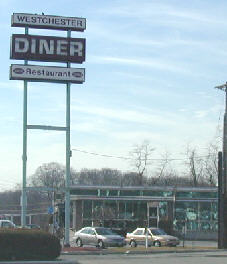KINGS FERRYNEW YORK |
 |
KINGS FERRYNEW YORK |
 |
| Kings
Ferry
During the Revolution this vital crossing was located here. Used by French and American armies on march to Yorktown in 1781. Cortlandt Historical Society, 1999 (Verplanck Marker) |
|
Kings Ferry was a major crossing point on the Hudson. It connected Verplanck’s Point on the east side of the Hudson with Stony Point on the west side. Since the British controlled New York City for most of the war, Kings Ferry was the southernmost crossing point for American personnel and supplies for most of the war. It was also a very important communication line between the north and the south. Therefore, Kings Ferry was a very strategic target for the British.
On October 5, 1777, Clinton dispersed the American forces at Verplanck’s Point and landed 3,000 troops to secure the area for an attack up river. On October 6th, they took Stony Point across the river and then moved north to take Fort Montgomery, Fort Clinton and Constitution Island.
On October 8, 1777, George Washington sent a letter to William Livingston. “Sir: I yesterday received certain intelligence, that the enemy had proceeded up Hudson’s River from New York, and landed a body of men at Verplanck’s Point, a few miles below Peekskill. … Should any disaster happen, it is easy to foresee the most unhappy consequences. The loss of the Highland passes would be likely to involve the reduction of the forts. This would open the navigation of the river, and enable the enemy, with facility, to throw their force into Albany, get into the rear of General Gates, and either oblige him to retreat, or put him between two fires.”
On May 30, 1779, the British returned to Kings Ferry. Six thousand troops left New York City, by land and water, and moved north toward Stony Point. On June 1st, while 40 American soldiers were finishing a blockhouse at Stony Point, the first British ships appeared in Haverstraw Bay. The soldiers burned the blockhouse and fled.
Also on June 1st, British forces attacked 70 North Carolina troops stationed at Fort Lafayette at Verplanck's Point. The American troops surrendered cutting off the important east-west link at King's Ferry. Also, the victories put the British in control of the gateway to the Hudson, just 12 miles south of West Point.
| Lighthouse
at Stony Point |
|
On the night of July 15-16, 1779, Brigadier General Anthony Wayne of Pennsylvania led the American Light Infantry in a daring midnight assault against the British forces at Stony Point. Two American columns outflanked the front line defenses and captured the garrison. The main assault column waded through the shallow waters of Haverstraw Bay, south of Stony Point. The secondary column approached around the north side of the Peninsula. The American victory at Stony Point was the last major battle in the north.
After the battle, the Americans destroyed the fort, removed the prisoners, and captured supplies and equipment, including 16 pieces of artillery. Two days later, General Washington abandoned the peninsula, having determined that it could not be defended against the combined might of the British army and navy.
When the Americans withdrew, the British returned, and built a second fort with blockhouses surrounded by an abatis, but the war continued to expand. Crown forces were fighting the French and the Spanish, now allied with the Americans. The additional burden on military resources, a decision to move the war to the American south and a lack of reinforcements compelled the British to abandon the forts at Stony Point and Verplanck's Point in October 1779. Kings Ferry was once again the southernmost crossing point on the Hudson.
| The American Strategy at
Stony Point
In reaction to Sir Henry Clinton’s move against Stony Point, the Continental Army marched north from New Jersey, to protect West Point, and a plan was devised to counter the British advance. Apprised of the formidable British defenses at Stony Point by Captain Allan McLane, an American officer who had gained entrance to the enemy fort, General Washington determined that a frontal attack in daylight would most likely fail. Consequently, a night assault, to be led by Brigadier General Anthony Wayne of Pennsylvania, was planned. Wayne commanded the Corps of Light Infantry, a select force which probed enemy lines, fought skirmishes and executed difficult missions. Two columns — a total of 1150 men — would comprise the Continental force. The main assault group of 700 men, commanded personally by General Wayne, would wade through the waters on the southern flank. At the same time, a smaller secondary column would approach from the north. To eliminate the possibility of accidental gunfire and preserve the key element of surprise, both columns were armed with unloaded muskets and fixed bayonets. In the center of the peninsula, two companies of North Carolina troops, commanded by Major Hardy Muffee, would fire volleys to distract the British and divert the fort’s defenders. An additional force of 300 men, under General Peter Muhlenberg of Pennsylvania, would be held in reserve. At midnight, July 15, 1779, the attack would begin. (Stony Point Marker) |
In August 1781, Washington made the pivotal decision of the American Revolution. He decided to abandon operations in New York, sneak across the Hudson at Kings Ferry with French troops under the command of General Rochambeau and immediately march to the south to surprise Cornwallis at Yorktown. The American victory at Yorktown was the last major battle of the American Revolution.
In the summer of 1782, the Continental Army took to the field for the last time at Verplanck’s Point. In a show of strength, the combined armies of General Washington and General Rochambeau demonstrated their might to the British bottled-up in New York City. The combined forces totaled 12,000.
The defeat at Yorktown, the assistance of the French and a war that had become unpopular in England forced the British to the peace table. Congress ratified the peace treaty on April 15, 1783 and the British evacuated New York City on November 25, 1783.
Today, a marker and a small park are at the spot where Kings Ferry leaves Verplanck’s Point. Across the Hudson, is the Stony Point Battlefield. On a clear day, you can see the lighthouse at Stony Point.
The Original Kings Ferry Crossing.
| Kings Ferry
This was the original site of this river crossing used in colonial days. Moved during the Revolution to the area of Fort Lafayette. Cortlandt Historical Society 1999 (Kings Highway Marker) |
|
The Post Hannock House -- This is where George Washington presented medals to the captors of Major John André, Clinton’s adjutant general. André was captured on September 20, 1780 attempting to pass between British and American lines in order to return to New York City after meeting with Benedict Arnold. Arnold was the commander of West Point and he wanted to complete final plans for his treasonous sale of West Point to the British. When Arnold heard about the capture of André, he commandeered a barge and its crew. Leaving his wife and child behind, he ordered them to row him out to the British ship, “the Vulture,” which was anchored out of range of West Point artillery. Arnold escaped, joined the enemy and led British forces against Americans in Virginia and Connecticut before hostilities would subside after Yorktown. Thus, the name, Benedict Arnold, and the name, traitor, would become synonymous. However, this Benedict Arnold is a very different Benedict Arnold than the one we will meet at the end of this “Revolutionary Day”.
| Post Hannock
House
Owner operated Kings Ferry 1664, Colonel Livingston’s Headquarters, 1781. Washington presented medals to captors of Major André here in 1782. Cortlandt Historical Society 1999 (Kings Highway Marker) |
|
The Kennedy House Marker -- Alexander Hamilton recuperated from illness here. Also, General Charles Lee was removed from command here. General Lee might have been able to end the American Revolution three years earlier if he had carried out Washington’s orders. He chose not to attack the vulnerable British army after they had abandoned Philadelphia to return to New York City in June of 1778.
| Kennedy House
Stood on this site. In 1777 Alexander Hamilton lay ill here for 2 weeks. The court martial that tried General Lee met here July 15, 1778. Cortlandt Historical Society 1999 (Kings Highway Marker) |
|
 The
Westchester Diner -- This classic diner is a good place to catch a quick
breakfast.
The
Westchester Diner -- This classic diner is a good place to catch a quick
breakfast.
